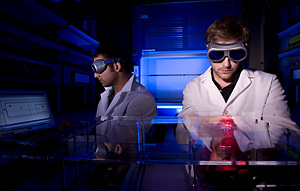Inside the Cullen College’s Biomedical Engineering Research Core Laboratory is a one-of-a-kind instrument that could help scientists better understand how radiation from low-level lasers affects cellular processes.
Yet the inventors of this machine are not seasoned researchers, but rather two University of Houston undergraduate students working to fulfill the last year of requirements for their biomedical engineering degrees.
Basilios Sideris constructed the instrument and computer program to run it with fellow classmate Arjun Vasan. Strategically pieced together from a 1970s era XY plotter, Plexiglas, a few nuts and bolts and a small laser mount with interchangeable visible and infrared diodes, the instrument is as unique as the theory it’s working to test.
“It’s a platform on which we can irradiate cultured cells with a low-power laser light at different wavelengths,” said Sideris. “The theory behind the low-level laser irradiation is that whenever you irradiate cells or wounds with a certain wavelength of light, different cellular processes can take place. For instance, accelerated wound healing or pain relief.”
One of the main components of the design is an XY plotter the two purchased in an online auction for a few hundred dollars.
Originally designed to draw continuous vector graphics in two axes of motion, Sideris and Vasan removed the plotter’s pen and replaced it with an arm holding a T-shaped Plexiglas stage. Through the use of coded computer commands, the arm moves the stage—carrying a 12-well plate of cultured cells—over a low-level laser mounted underneath.
Interchangeable diodes allow the laser to emit different wavelengths of light. In the quest for more accurate results, a diffuser lens assures the lasers power is distributed evenly across the diameter of each well.
Despite all their upgrades, the homemade instrument runs on the same basic concept as the more than 30-year-old plotter.
“You connect it to the computer, key in the voltage and the computer tells it how much voltage to feed and that way you can send the arm to a specific location on the plane,” Sideris said. “Based on those movements, we can irradiate whichever well we want.”
During his capstone design class Vasan created a set of operating instructions for the machine using the programming language, LabVIEW.
“The program loads a text file which contains a set of voltage pairs, one voltage for the x and y axis, much like a coordinate pair and these values are then outputted to the plotter to move it into position,” said Vasan. “Through the LabView interface the user can adjust the amount of time each well spends over the laser source thus giving the researcher the ability to control the amount of energy the cells receive. The key feature of the program is that it allows for the automation of experiments; once the user decides what size culture (12 or 24 well) plate to use and how much energy the cells need they can load the appropriate text file, set the timing and then sit back while the machine irradiates the cells for them.”
Both constructed the instrument over the course of a year. With a little help from senior architect major Dane Collette on design programs and the equipment to cut the Plexiglas stage, the two finally finished the instrument this fall. They are now working to further perfect the device by adding an environmental control chamber.
With a spring completion predicted, the chamber would better mimic the conditions of the body, both said, and provide more accurate results in studies requiring cells be exposed longer to the low-level laser irradiation.
Many cellular processes change in two hours, for example, the pH will rise significantly and the temperature will drop, instigating undesirable biochemical events, Sideris said.
“In order to run the experiment as well as possible, we are trying to incorporate the environmental chamber and eliminate those variables completely,” he said.
The addition will be the subject of Sideris’s honors thesis, which he plans to complete before both graduate later this year.
Their instrument, the two have said, will remain with the college and one faculty member in particular, Daniel Martinez. An associate professor in the department of health and human performance and the college’s biomedical engineering program, grant funding from a related project allowed Martinez to help fund the students work.
